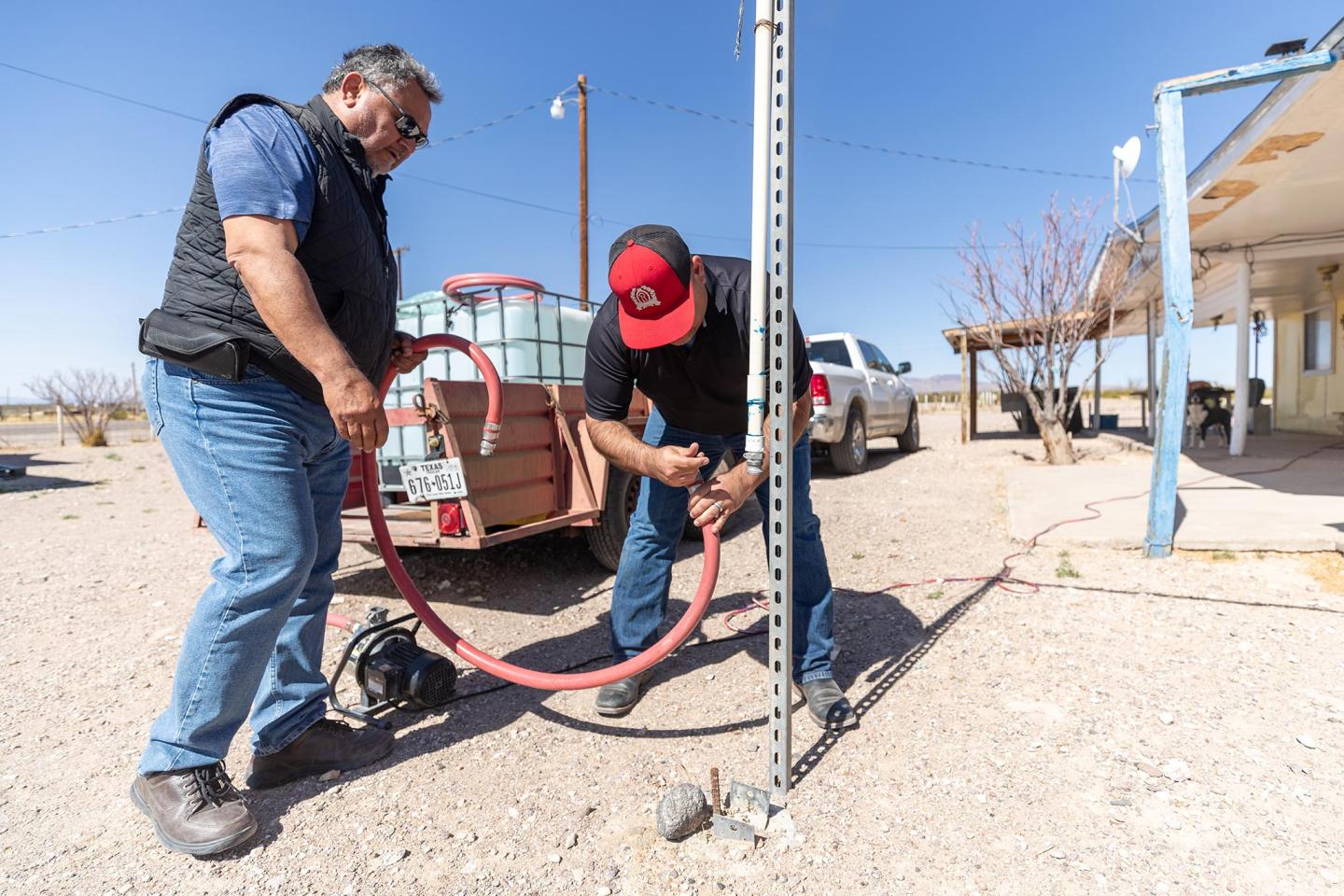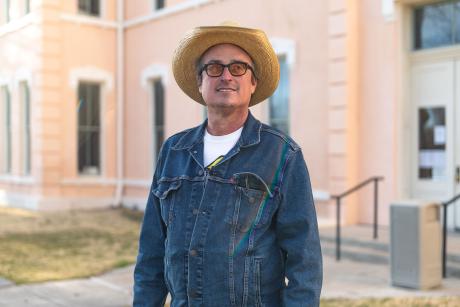
Water hope for Texas’s drought-stricken borderlands
For communities in the heart of the Chihuahuan Desert, water shortages are a way of life.
Photos by Mohammad Shahhosseini
It’s a familiar errand to many in Presidio County and throughout West Texas: Once a week — or twice in the hottest months — José Acosta meets his uncle, Luis Felipe Lujan, to help him bring water to his house.

Just a stone’s throw from the Mexican border, in the town of Presidio, the men fill two 500-gallon plastic water tanks, which they tow nine miles uphill to a cluster of modest houses known as Las Pampas Colonia.
"I like living here because it’s very calm,” says Lujan. “The only problem is that we have to haul water to live normally. That's more or less my life here."
Simple things like taking a shower, or doing the laundry, involve careful calculations. "We have to economize as much as possible to avoid going for water too much,” he adds.
Lujan lives in a cluster of modest houses known as Las Pampas Colonia. Colonias are unincorporated settlements that often lack basic amenities like running water, sewage systems and even electricity.
There are more than 2,000 colonias in the United States, home to around 840,000 people, the majority along the Texas-Mexico border. In many cases, developers sold lots to low-income immigrants, promising to bring services that never materialized.

A crisis decades in the making
A drought and decades of overuse have led to shrinking aquifers — a situation that will likely continue to worsen as temperatures rise, droughts intensify and the state’s population continues to grow.

“All across the west, we’re seeing a more arid climate," says Vanessa Puig-Williams, who heads the Texas water program at Environmental Defense Fund. "Drought is the norm. Particularly in West Texas, a lot of communities here don’t have access to reliable, clean drinking water — either because they are living in an area where it was promised and never provided, or because of a lack of county resources to maintain water systems.”
In colonias like Las Pampas, rates of water-borne diseases such as hepatitis A, dysentery and salmonellosis are higher than in the rest of the state. Even if tap water is clean, it can easily become contaminated as it moves through the patchwork of portable tanks, collection barrels, pumps and makeshift pipes that serve houses.
And yet, there is water here.
Far under the surface of the Chihuahuan Desert, complex networks of aquifers remain mostly untapped and poorly understood. Management efforts are often complicated by the fact that groundwater districts are based on counties, not water flow, and regional cooperation has been lacking.

“We need deep wells and infrastructure to get that water to where it’s needed,” says Trey Gerfers, a Marfa resident who directs the Presidio County Underground Water Conservation District. Gerfers leads a team of local residents from six communities who are working to access federal, state and private funds to bring water equity to the region.
“Traditionally, counties like Presidio have been shut out of programs…because we don’t have the expertise,” says Gerfers. “We don’t have the knowledge to navigate the labyrinth of bureaucracy and applications.”
That's where Puig-Williams and her team come in. EDF funded an engineering consultation to support an application for state funds for groundwater monitoring and modeling, new wells, pumps and other infrastructure investments. The global climate non-profit is also helping leaders navigate the bureaucracy of funding processes to bring first-time water service to several communities in the county.'
A ghost town reborn
A few miles north of Las Pampas colonia, Shafter was once the site of a thriving silver mine. Now, about 30 residents live among the slowly dissolving ruins of roofless adobe structures.
Shafter residents have long depended on makeshift storage tanks and a fragile network of PVC pipes to bring water from the defunct mine’s 900-feet-deep well.
When a new company purchased the mine in 2008, it continued providing water even after mining operations ceased.
But recent rumors of a pending sale or possible bankruptcy, and a series of pump breakdowns, have kindled concerns that taps could soon go dry.
“A lot of people here are older people, we’re retirees,” says Shafter resident Julia West. “We’re concerned when we’re without water for a day or two. We all wonder, will we have water tomorrow?”

A cause for optimism
Water access in both Shafter and Las Pampas is governed by the Presidio County Water Infrastructure Steering Committee. The committee, which includes representatives from multiple towns, meets in the ornate 19th-century courthouse in Marfa, the county seat. EDF has been working with the steering committee to help its members identify sources of funding to meet some of their water needs.


Inside the ornate 19th century courthouse in Marfa, county commissioner David Beebe discusses Presidio County's water woes. (Beebe photo by Tom Clynes)
At a recent meeting, Gerfers had good news. He’d received notice from the state government that Presidio County had been awarded $4 million in state funding, for water projects in Las Pampas, Shafter and Marfa.
“We've got several million dollars available to us to do a number of projects, and hopefully we might be able to get some more,” said committee member David Beebe, a Marfa resident and county commissioner. “This is the biggest opportunity we've had in at least a generation, if not two or three.”
Some of the funds will go toward planning and design of deep wells and pipes to transport drinking water to homes in Las Pampas and Shafter, as the county awaits approval of federally funded construction. But that's not all.
Sustainability is key
With the help of EDF and partners, Presidio County communities are embarking on a series of green infrastructure projects to restore waterways, plant trees and otherwise get ready for the increasing effects of climate change in the hottest, driest part of the state.
“So often the focus is on jobs and growth and pipes and infrastructure,” says Gerfers. “Those are all important, but we need to take care of where that water's coming from and understand how it’s responding to climate change and drought. If we don’t preserve and enhance those groundwater resources, we’ll be building pipes that will ultimately be empty and creating jobs that will disappear.”
Gerfers hopes the county's work can be a model for other regions in Texas and beyond to address their water infrastructure challenges holistically.
“We are the driest part of Texas,” he says. “If we’re able to pioneer some interesting watershed restoration approaches or different ways of enhancing and managing our aquifer resources....I think those successes can readily be transferred to other parts of the state that are wetter than ours but will become successively dryer with climate uncertainty.”
Back in Las Pampas Colonia, Lujan and Acosta pump the water they’ve hauled from town into a storage tank on their property. Next door is a pizzeria that was abandoned because there was no water to wash the dishes.
“If we get water, it would change everything about life here,” Lujan says.
“We could even reopen the pizzeria,” Acosta adds. “People and businesses may start to come back. When water comes, everything blooms.”








